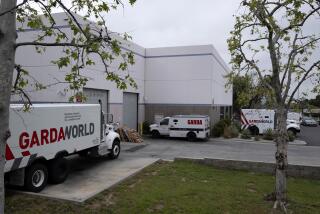Crystallizing Support for a Crystal-Clear Bay : Environment: The “Jewel of San Diego” is one of the nation’s most polluted waterways. But a group called Baywatchers says concerned residents can help turn the situation around.
When Dave and Sam Sheehan decided to join the ranks of the flag-flying Baywatchers, they figured they should do it in a big way.
After all, their 27-foot boat, the “Lil’ Sucker,” is a common sight on San Diego Bay, where the couple runs an oil-changing and recycling business (what Dave calls “a Jiffy Lube for boats”). Dave figured that, in a potentially messy business like his, it was important to make it clear where he stood.
“I do carry hazardous waste and so far, knock on wood, I haven’t spilled a drop,” he said. “But I’m extremely visible on the bay, so every time there’s some oil on the water, somebody points a finger at me.”
So the Sheehans became Baywatchers, joining the Environmental Health Coalition’s Clean Bay Campaign to encourage bay users to become environmental watchdogs. And, instead of flying the campaign’s official 1-foot “Clean Bay/Toxic Free” pennant, they had a 4-foot banner specially made to attract attention to what they believe is an urgent cause--cleaning up San Diego Bay, one of the nation’s most polluted waterways.
Ideally, the Sheehans say, the only finger-pointing they’ll see now will be aimed at the blue flag atop their boat. “Ask Me About Baywatch,” it commands. And those who do are likely to hear a tale.
Dave Sheehan has his share of horror stories--he’s heard about more than one boat owner who has pumped big globs of black crud out of his bilges and into the bay. Last Wednesday and Thursday alone, he says, there were five diesel fuel spills in the bay. And on any given day, he can point to the results.
“See that floating there?” he asked, nodding toward the shiny residue floating near the dock in Point Loma where he keeps his boat. “That’s diesel. And those black streaks in the water? Lube oil.”
After decades of receiving boating wastes, industrial emissions and urban runoff from storm drains, the bay is full of potent pollutants, including heavy metals such as lead and mercury, pesticides like DDT and other toxins, such as PCBs. According to the Environmental Health Coalition, these concentrated pollutants have created several “toxic hot spots”--some of them among the worst toxic deposits in the region.
Since 1987, the Clean Bay Campaign has fought for improvements, focusing its efforts on lobbying the San Diego Unified Port District and the Regional Water Quality Control Board, which are responsible for protecting the bay’s well-being. But, until the creation of Baywatch, the campaign had no formal way for people like the Sheehans to get involved.
Now, for a $10 fee, San Diegans interested in cleaning up, restoring and protecting the bay can purchase a Baywatch kit, complete with a pennant and a how-to guide for preventing and reporting toxic spills, both on the bay and upstream.
Membership is not limited to boaters. Much of what causes the bay’s pollution, campaign organizers stress, is on shore: petroleum products, pesticides, cleansers and other toxics that are dumped into storm drains that flow into the bay.
“Baywatch is all about people taking back this public waterway and being able to make full use of it,” said Jay Powell, the Environmental Health Coalition’s program coordinator. “Let’s keep toxics out of the gutter. And let’s stop using products that will harm the bay. We want to make it fishable and swimmable.”
Before that goal is reached, however, there is a long way to go. Several state and federal studies based on samples of fish caught in the bay have found the pollution to be severe, causing reproductive, physiological and behavioral disorders in bay life. The health risk to consumers of bay shellfish and other fish is being evaluated by the county, which is scheduled to complete the first draft of a $284,000, 18-month study in March.
Regardless of the results, Dave Sheehan won’t be baiting his hook.
“I know what’s on the bottom down there,” he said. “Yeah, we’re getting more environmentally aware. But our grandfathers didn’t know, and they didn’t care.”
The history of dumping in the bay is a long and colorful one. Before the Point Loma Waste-water Treatment Plant was built in the 1960s, raw sewage was channeled directly into the bay, causing visible pollution. After the sewage was diverted to the plant, the bay once again regained its picture-postcard image as “The Jewel of San Diego.” But, in recent years, a less visible form of pollution has been discovered in the sediments that sit on the bay’s bottom: high levels of toxic chemicals.
Industry, from shipyards to aeronautical and defense firms, is responsible for much of the contamination. In 1988, for example, the regional water board fined Teledyne Ryan Aeronautics for discharging cancer-causing polychlorinated biphenyls, or PCBs, from its transformers into storm drains leading to the bay at Convair Lagoon. The company is now investigating appropriate cleanup levels and will report to the board in March.
In the meantime, however, according to the State Mussel Watch program’s studies of toxics in mussel tissues, Convair Lagoon has the highest recorded levels of PCBs on the West Coast. And, because PCBs do not break down quickly, that is not likely to change until a cleanup is begun.
Although these forces are beyond the reach of most Baywatchers, campaign organizers hope that, instead of being discouraged by the scope of the problem, volunteers will work to set an example--for other individuals and for businesses as well.
“Clearly, it’s not within an individual’s power to clean up all the toxins in the bay,” said Diane Takvorian, executive director of the Environmental Health Coalition. “What Baywatchers are doing is precisely what industry ought to be doing: taking the bull by the horns.”
The idea behind Baywatch is not a new one. Maryland’s privately funded Chesapeake Bay Foundation has a 5-year-old Baywatchers group whose 5,000 members interpret the name broadly: as well as keeping their eyes on the water, they have been known to lobby their legislators and build hiking trails.
Jay Sherman, the director of the foundation’s grass-roots program, said a big part of his job is reminding people how development on land affects pollution in the bay.
“People who dump their used motor oil down the drain just think it goes away. It doesn’t. It goes into the bay,” Sherman said. “Whether you live in San Diego or Baltimore, the care you take when you change the oil in your car, the amount of fertilizer you use in your garden, all these things will affect the quality of your water resource.”
Kathy Callison, president of Seattle’s Puget Sound Alliance, agrees. She has received $36,000 from Washington state to create its first Sound Keeper program. Like similar programs in New York state, Callison’s program will hire a full-time advocate for the waterway, called a Sound Keeper, who will be responsible for the stewardship of the bay.
“Our Sound Keeper will be a citizen ombudsperson, the eyes and ears of the public and a lightning rod for complaints,” Callison said. “We need to have somebody who really stands at the helm, but we’re going to focus on creating a network, a Puget Sound environmental navy.”
Joyce Nichols of the Puget Sound Water Quality Authority, the state agency that is funding the Sound Keeper program, said the goal is to educate.
“It’s public awareness that will prevent pollution from getting into the water in the first place,” she said. “You can do something about pollution because you’re out there, and you see it. All you have to do is know whom to call.”
The San Diego Baywatcher’s Guide is full of phone numbers: the Coast Guard, the Harbor Police, the county hazardous materials management division. It is also brimming with ideas about how to get involved. Fourth-, fifth- and sixth-graders can help stem urban runoff, the guide says, by painting storm drains with a duck and the message “No Dumping: I Live Downstream.” Adults can be more discriminating at the check-out counter, according to the guide, by buying non-toxic cleaning and garden products.
And anyone can participate in Earth Day on the Bay on April 21, the eve of the 20th anniversary of Earth Day. A “Clean the Bay Boat Parade” of several hundred vessels will travel from Shelter Island to the Coronado Bay Bridge and back again.
Ed Gillet, a Baywatcher who usually keeps an eye on the bay from the seat of his kayak, said he is selling Baywatch kits at his Point Loma store, Ecomarine Ocean Kayaking, because he thinks community action is the only way to tackle the problem.
“Toxic waste is all of us,” he said. “It’s not just big polluters dumping toxic waste into the bay. All of us are responsible on a small scale. We all need to be a little more careful.”
SAN DIEGO BAY POLLUTION
SAN DIEGO BAY’S TOXIC HOT SPOTS
(1) COMMERCIAL BASIN: (Copper, mercury and TBTs) Contamination is believed to be a result of boat cleaning and repairing. The Regional Water Quality Control Board has ordered cleanup and abatement at seven boatyards. New rules require that boatyards monitor the basin’s sediment.
(2) NORTH ISLAND: (PCBs) Higher levels of PCBs around the northern shore of North Island are attributed to the possible discharge of hydraulic fluids from the North Island Naval Air Station. No cleanup action has been ordered, but the Navy has agreed to apply for federal pollutant discharge permits.
(3) CONVAIR LAGOON: (PCBs) Extensive contamination of sediment in the bay has been attributed to Teledyne Ryan Aerospace. Cleanup was ordered in 1987 and a fine was levied in 1988. The company is investigating appropriate cleanup levels and will report to the Regional Water Quality Control Board in March.
(4) STORM DRAINS: (PAHs and pesticides) More than 100 storm drains carry urban runoff into the bay. Pesticide and herbicide runoff from lawns, and petroleum products from streets and parking lots are major contributors. The foot of Laurel Street has a large storm drain outlet.
(5) THE DOWNTOWN BLOB: (Underground petroleum plumes) This network of subterranean plumes sits under a nine-block area of downtown where extensive redevelopment has taken place. As the more than 500,000 gallons of fuel in the plume migrate toward the bay in the vicinity of the Convention Center, attempts to identify responsible parties have been stalled. No cleanup is scheduled.
(6) SHIPYARDS: (Copper and other heavy metals) Old paint chips and sandblasting grit have fallen into the bay for years during the process of repairing ships. New monitoring requirements have recently been incorporated into the shipyards’ discharge permits, but no cleanup orders have yet been issued to shipyards that dump sandblasting wastes.
(7) 28th STREET PIER: (Copper, DDT, lead, PCBs, zinc) No responsible party has been identified or cited for the elevated levels of heavy metals and toxins in the water here. No cleanup action has been ordered.
(8) PACIFIC STEEL: (Heavy metals) Shredded waste containing heavy metals is watered down here and seeps into the soil, contaminating storm water that empties into the bay. The Regional Water Quality Control Board has ordered a cleanup of the soil by Aug. 1 and has required Pacific Steel to plan to begin sampling the ground water under the premises.
(9) PACO TERMINAL: (Copper concentrate) From 1979 to 1987, spillage and drainage of copper from loading operations resulted in a 13,000-fold increase in the copper level in the bay’s sediment. A cleanup was ordered in 1987. A fine was levied in 1988 and the San Diego Unified Port District was named as a responsible party with Paco in 1989. No cleanup action has yet been taken.
Source: The Environmental Health Coalition
POLLUTANTS FOUND IN SAN DIEGO BAY
DDT (dichloro-diphenyl-trichloroethane): This insecticide has been banned in the United States, but DDT residue is still found in San Diego Bay. DDT accumulates in the bodies of marine organisms and works its way up the food chain.
Heavy metals: These include cadmium, chromium, copper, lead, manganese, mercury, nickel, silver and zinc. Lead attacks the human central nervous system. Mercury can accumulate in plankton algae and fish. Copper accumulation in the human body can result in clinical abnormalities of the nervous system, liver, kidneys and cornea.
Organic chemicals: Highly toxic cleansers, synthetic industrial chemicals or byproducts of the industrial process and pesticides or herbicides can enter the bay through storm drains and streams.
PAHs (poly-aromatic-hydrocarbons): Found in oil and other petroleum products, these substances enter the bay through spillage and dumping or via the storm drains, which carry urban runoff.
PCBs (poly-chlorinated-biphenyls): Formerly used in transformers and hydraulic fluids and other industrial processes, PCBs are extremely resistant to breaking down. The use of PCBs has been widely banned because of its extreme toxicity.
TBT (tri-butyl-tin): An anti-fouling agent designed to protect boat bottom paints, TBT was detected in mussels placed in San Diego Bay near marinas and boatyards. TBT, which is toxic to marine life at very low concentrations, has since been banned for use on boats under 82 feet long.
Source: The Environmental Health Coalition
More to Read
Start your day right
Sign up for Essential California for news, features and recommendations from the L.A. Times and beyond in your inbox six days a week.
You may occasionally receive promotional content from the Los Angeles Times.






